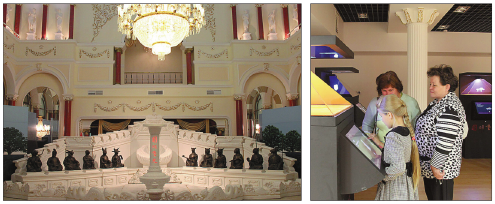An exhibition of models, 3-D images and videos has brought the Old Summer Palace, known as Yuanmingyuan, back to life, giving a fascinating insight into the life of China's royal families. Sun Yuanqing reports.
More than a century after it was looted and burned down, Yuanmingyuan, or the Old Summer Palace, has been restored to its former glory in a unique way.
 |
| The ongoing exhibition, Glory of the Yuanmingyuan, in Moscow, features a miniature model of Haiyantang, the largest European garden in Yuanmingyuan, along with replicas of the 12 bronze zodiac animal heads that adorn its fountain. Above right: Visitors at the holographic displaying hall. |
Exhibition Glory of the Yuanmingyuan, evokes the history and culture of Yuanmingyuan through models, 3-D images and videos. It is currently on display at the Chinese Culture Center in Moscow in celebration of the China-Russia Tourism Year.
"It is a breakthrough in the history of Yuanmingyuan," says Chen Yanying, co-curator of the exhibition. "It is not meant to condemn the countries that took part in the turmoil, instead, it is going to send a positive voice, to let more people learn about and come to visit Yuanmingyuan."
Yuanmingyuan's cultural relics, artworks and architecture that were looted or destroyed in the late 1800s and early 1900s, have now been brought to life on the touch panels. A miniature model of Haiyantang, the largest European garden in Yuanmingyuan, also made its debut, along with replicas of the 12 bronze zodiac animal heads that adorn its fountain.
One of the highlights of the event are the various interactive programs that allow visitors to not only appreciate, but also take part in the creation process of art, says Chen.
"For people who know little about Yuanmingyuan, pictures alone can't do it," says Chen. "That's why we need to develop experience centers to help people in other countries relate to Yuanmingyuan."
In the experience center of royal architecture design, visitors can try to build architecture models, discovering how Chinese architecture takes shape without using nails and glue.
In the miniature Banmuyuan Garden, the place where the royal family watched opera, there are handmade embroidered costumes and puppets, which visitors can try on and pose for photographs with. In the imperial schoolroom, where the princes of the royal family used to study, visitors can learn Chinese calligraphy.
The most popular part of the exhibition has been the imperial cuisine experience center, says Chen.
Two veteran chefs have been invited from Beijing to demonstrate Chinese royal pastry making. The pastries are then given away for free to the visitors for a taste of Chinese royal life.
First built in 1707 during the Qing Dynasty (1644-1911), Yuanmingyuan was maintained and expanded by various emperors in the following 150 years. It measures about 350 hectares, equivalent to more than 490 football fields. Because of its extensive collection of gardens, architecture and other artworks, Yuanmingyuan is also known as "the Garden of Gardens".
Compared with other scenic spots in Beijing, Yuanmingyuan is the place with the greatest political legacy, says Zhang Chao, director at the research institute in Yuanmingyuan.
"The emperors generally spent two thirds of their time in Yuanmingyuan, so did the ministers," says Zhang. "Together with the Forbidden City, Yuanmingyuan formed the political center in the later half of the Qing Dynasty."
